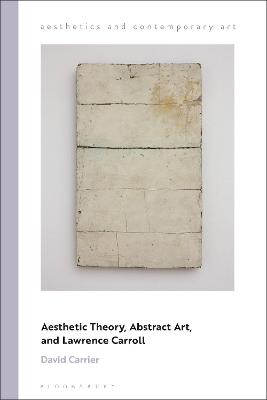Aesthetics and Contemporary Art
2 total works
Boldly developing the central traditions of American modernist abstraction, Lawrence Carroll's paintings engage with a fundamental issue of aesthetic theory, the nature of the medium of painting, in highly original, frequently extraordinarily successful ways. Aesthetic Theory, Abstract Art, and Lawrence Carroll explains how he understands the medium of painting; shows what his art says about the identity of painting as an art; discusses the place of his paintings in the development of abstraction; and, finally, offers an interpretation of his art. The first monograph devoted to him, this philosophical commentary employs the resources of analytic aesthetics. Art historians trace the development of art, explaining how what came earlier yields to what comes later. Taking for granted that the artifacts they describe are artworks, art historians place them within the history of art. Philosophical art writers define art, explain why it has a history and identify its meaning. Pursuing that goal, Aesthetic Theory, Abstract Art, and Lawrence Carroll roams freely across art history, focused at some points on the story of old master painting and sometimes on the history of modernism, but looking also to contemporary art, in order to provide the fullest possible philosophical perspective on Carroll's work.
The artwork of Maria Bussmann, a trained academic German philosopher and a significant visual artist, provides an ideal test case for a philosophical study of visual art. Bussmann has internalized the relationship between art and philosophy. In this exploration of the history of German aesthetics through Bussmann's work, David Carrier places the philosophical tradition in the context of contemporary visual culture.
Each chapter focuses on the arguments of a major philosopher whose concerns Bussmann has dealt with as an artist: Kant, Hegel, Merleau-Ponty, Wittgenstein and Arendt. Offering comparative accounts of artists and philosophers whose work is of especial relevance, Carrier shows how Bussmann responds visually to writings of philosophers in art that has an elusive but essential relationship to theorizing. Tackling the question of whether philosophical subjects can be presented visually, Carrier offers a fresh perspective on the German idealist position through the visual art of 21st-century artist steeped in the tradition and continually challenging it through her work.
Each chapter focuses on the arguments of a major philosopher whose concerns Bussmann has dealt with as an artist: Kant, Hegel, Merleau-Ponty, Wittgenstein and Arendt. Offering comparative accounts of artists and philosophers whose work is of especial relevance, Carrier shows how Bussmann responds visually to writings of philosophers in art that has an elusive but essential relationship to theorizing. Tackling the question of whether philosophical subjects can be presented visually, Carrier offers a fresh perspective on the German idealist position through the visual art of 21st-century artist steeped in the tradition and continually challenging it through her work.

